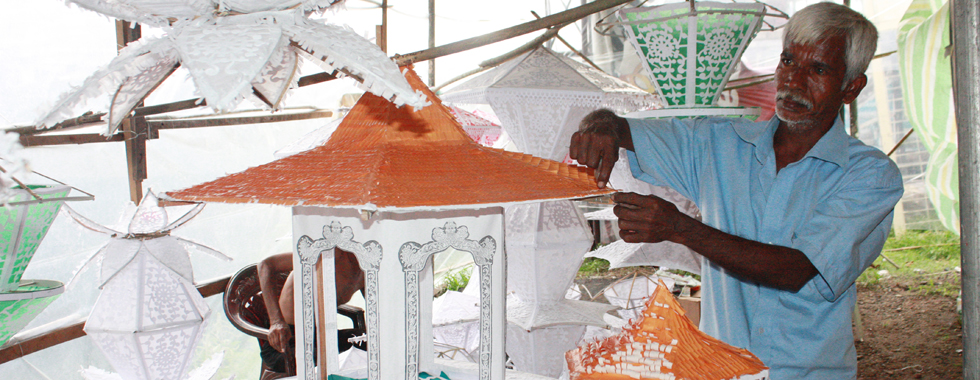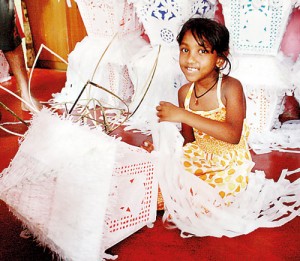Working day and night to spread the light
Vesak, the festival which marks the Birth, Enlightenment and the Passing Away of Lord Buddha sees every mansion and humble home, shopping mall, office complex and wayside kade being illuminated with sparkling lanterns, flags, bulbs, lamps and other decorations.
In the days gone by, making lanterns or Vesak kudus was something that both young and old looked forward to. Today, though, with their busy lifestyles, city dwellers are not into making their lanterns and prefer the instant solution- buying them ready-made.

Beautifully crafted: K. Thuthipala puts the final touches to a lantern modelled on the Dalada Maligawa
So to cater to this demand are people who treat this lantern making ritual with much seriousness. The lantern sellers, who put up temporary roadside sheds with their creations- the attapattam, bilin kudu, nelum mal few days prior to Vesak Poya, work around the clock, to spread the radiance of Vesak in the city. Interestingly, they do this putting aside their routine work- and household chores etc.
Although these lanterns come out only two or three weeks prior to Vesak, they start work months in advance, the Sunday Times learns.
In a two-roomed abode down Second Lane, Kirula Viyapara Watte in Kirulapone, Chaminda Pushpakumara has stacked a pile of beautiful Vesak lanterns. These creations, adorned with ketayam will go into the stalls in Kirulapone this week, just a few days prior to Vesak.
According to Chaminda, they start the process in mid-December by cutting and collecting the required quantity of bamboo sticks to meet his target of 3000 lanterns. The basic frame is done in January; pasting the structures somewhere around March and the final touches closer to Vesak, Chaminda explains. Given that they are unable to cope up with the demand, they even outsource the pasting task to those in the watte, he says.
Chaminda is helped by his wife Priyadarshani, their 15 -year-old twin sons and seven year-old daughter every year.
“There is a huge demand for lanterns now as people do not have time to make them. In addition to what I have already made, once we move the products to the stall, we keep on making more, depending on the demand,” Chaminda says.
“When the stall is opened, we are unable to come home. We stay there day and night,” he adds.

All in the family: Chaminda’s little daughter does her bit to beautify a lantern
It is by selling kola kenda and driving a three-wheeler that this husband and wife duo earn a living, but at this time of year, Priyadarshani sells kolakenda while Chaminda stops driving the three-wheeler to put in the extra hours of work for making the lanterns.
A few houses away Nilanthi Lakmali, a housewife and her 55-year-old mother are seen seated in their living room, leaning against a stack of Vesak lanterns- 300 lanterns made since December. Scattered all over the ground are bits and pieces of colourful tissue paper, glue bottles and bamboo sticks as they are now doing the cardboard lanterns, they say.
“We will make more as and when orders come,” she says adding that this Vesak she will be having her own stall in Kirulapone instead of giving them to the sellers on the road.
Putting the final touches to a beautifully crafted Vesak lantern that resembles the Dalada Maligawa was K. Thuthipala near the Kirulapone bridge.
“I have a separate room upstairs at home right over there to store the lanterns which we make months before Vesak,” he says pointing in the direction of his house. “These are all my relations who are helping me- my in-laws, nephews and grandchildren. We generally start somewhere in August as we even create designs that can go into competitions,” he says adding that a few days prior to Vesak, he gets leave from his employer.
“Once about 150 lanterns we did for Sambuddha Jayanthi celebrations were eaten by rats while they were kept piled up in the stores because we used pappa. Now we use binder gum instead,” Thuthipala said.
Although business has been satisfactory during the previous years, Thuthipala is worried that the monsoon rain would discourage people from coming to buy the lanterns this year.
Thuthipala says it is not for mere profits that he takes to this task every Vesak -as was done for the past 10 years- but for the joy of contributing to this hallowed festival.
-D.S. and H.S.


